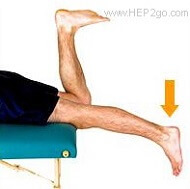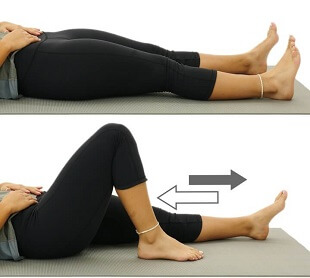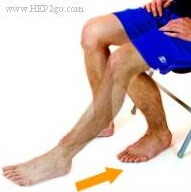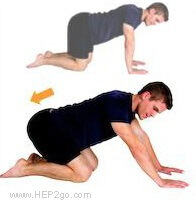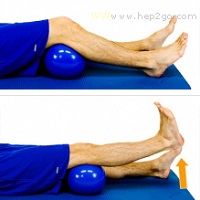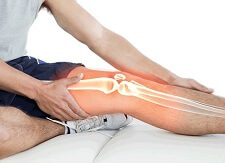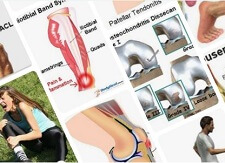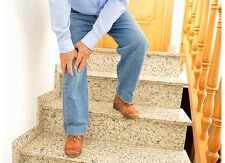- Home
- Common Knee Injuries
- Meniscus Tear
- Excercises
Meniscus Tear Treatment
Written By: Chloe Wilson, BSc(Hons) Physiotherapy
Reviewed by: KPE Medical Review Board
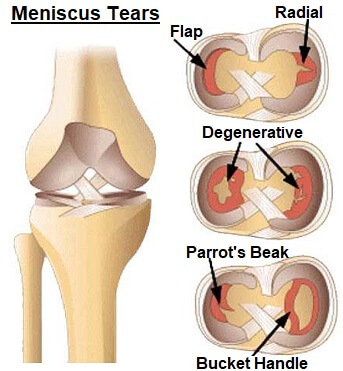
Meniscus tear treatment aims to reduce the pain and inflammation associated with a knee cartilage tear as well as restore strength, flexibility and function. A torn meniscus is one of the most common causes of knee pain.
The meniscus is a special thick layer of cartilage that lines the knee joint providing cushioning and support.
When the meniscus get torn, either through a twisting injury or gradual wear and tear, it can lead to weakness, stiffness, locking and pain in the knee. Most commonly, there is a medial meniscus tear, on the inner side of the knee.
It can take quite a while to recover from a meniscus injury as the cartilage has a poor blood supply which slows healing so effective treatment is vital.
Meniscus Tear Treatment Options
Meniscus tear treatment options fall into two categories:
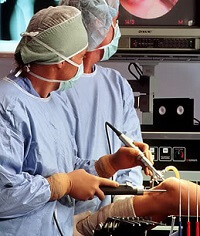
- Surgical Treatment: where part of the meniscus is trimmed or removed via keyhole surgery. This is usually done if pain continues despite trying non-surgical treatment, or there are problems with locking, where the knee gets stuck in one position due to a flap of cartilage blocking the joint, surgery may be required.
- Non-Surgical Treatment: In the early stages, meniscus tear treatment aims to reduce the pain and inflammation through the use of ice, medication and occasionally knee braces. For the long term, the best meniscus tear treatment is exercises to strengthen the knee and regain full movement.
Whether you are going down the surgical or non-surgical meniscus tear treatment route, exercises are really important and here you will find a whole range of exercises that should help.
To find out more about other meniscus tear treatment options including knee braces and surgery, as well as the different types of tear, the common causes and symptoms, visit the meniscus tear overview.
Meniscus Tear Exercises
Exercises are one of the best meniscus tear treatment options both short term and long term, whether or not you have surgery. They aim to increase the strength of the muscles around the knee so that the amount of weight going through the cartilage is reduced, allowing it to heal.
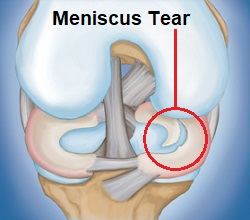
There are two main aims with meniscus tear treatment exercises:
- Regain full range of movement: knee bending and straightening
- Regain full strength:of the quads, hamstrings and glutes
Here we will look of a range of meniscus tear treatment exercises that can help. You don’t have to do all of them, pick two or three from each category that
feel best for you, and stick with those.
Regaining Full Movement
When you have a meniscus injury, or after meniscus surgery there tends to be swelling in the knee joint which stops it being able to fully bend and straighten.
It is much harder work for the body to function with a knee that doesn’t have full range and the torn meniscus ends up taking more weight through it, which can slow down the healing process and make it more prone to damage.
Regaining full range of movement at the knee is therefore a vital part of meniscus tear treatment.
1. Quad Clenches
Purpose: enable full straightening of the knee, maintain and strengthen the Quads without moving the knee
Starting position: Lying flat on your back or sitting up. Leg and knee straight
Action: Tighten the muscle on the front of the thigh by pushing your knee down. You should feel your thigh muscles clench. Hold for 3 secs
Repetition: Repeat 10-20x every 3-4 hours
Variations: If you are struggling to get your knee to straighten fully, place a rolled up towel underneath the ankle so that your leg is lifted slightly on the bed. Then do the exercise as described. Lifting the knee up slightly lets gravity help the knee to straighten
2. Prone Knee Hangs
Purpose: Meniscus tear treatment exercise to increase knee extension (how much the knee straightens)
Starting Position: Lie on your tummy with your kneecap just over the end of the bed/table
Action: Relax your leg and straighten the knee allowing gravity to help it to stretch down into a straighter position. Hold for 1-2 minutes then gently bend and straighten your knee a few times to stop it getting stiff
Repetition: Repeat 3x, 2x daily
Note: Do not stay in the position for too long as it can make the knee feel very stiff - limit to about 5 minutes
3. Heel Slides
Purpose: Regain full flexion (bending) of the knee, aids circulation
Intro: This is a really good meniscus tear treatment exercise to do first thing in the morning to loosen your knee up before you get up
Starting position: Lying flat on your back or sitting up. Leg and knee straight out on a bed or along the floor.
Action: Slide your heel towards your bottom as far as you comfortably can, bending your hip and knee. Keep your heel on the bed/floor. Hold for 3-5 secs and slowly return to starting position
Repetition: Repeat 10-30 times, 2-3x daily. Gradually aim to bend your knee a little more each time
Progression: Carry out the exercise as above but when you’ve bent your knee as much as you can hook a towel over the ankle and pull it towards you to help the knee bend further – you can achieve the same effect by hooking your opposite foot over the ankle and pushing with that leg to gain more knee bending.
Variations: Make this meniscus tear treatment exercise easier by placing a board or a plastic bag underneath your foot so you have a slippery surface making it easier to move
4. Foot Slides
Purpose: Increase knee flexion and aid circulation
Starting position: Sitting on a dining chair with your knee bent and your foot on the floor
Action: Slide your foot backwards on the floor as far as comfortable so you are bending the knee more. Hold for 3-5 secs
Repetition: Repeat 10-25x 3x daily
Progression: 1. Hook your other foot around the front of the ankle and push backwards with it to further bend your knee
2. Once you have slid your heel back as far as you can, raise yourself up
on your chair using your arms and slide you bottom forwards keeping your
foot still. You will find this makes your knee bend even more
5. Cat Stretch
Purpose: Meniscus tear treatment exercise to increase knee flexion to ensure knee bends fully
Starting position: Get on all fours on the floor, knees directly under hips and hands under shoulders
Action: Sit back taking your bottom towards you heels as far as you can. Hold for 3-5 secs
Repetition: Repeat 10x, 2x daily
Strengthening Exercises
The stronger the knee muscles are, the less weight goes through the knee joint and therefore the torn meniscus. Muscles lose strength after just a few days of rest so it is vital to build up strength as soon as possible.
Having good strength in the muscles also ensures that the
weight which does go through the torn meniscus is distributed evenly,
again speeding recovery. Strengthening exercises are therefore another vital part of meniscus tear treatment.
1. Short Arcs
Purpose: Meniscus tear treatment exercise to strengthen the quads muscles without requiring much knee movement
Starting position: Lying flat on your back or sitting up with your leg horizontal on a flat surface such as a bed. Place a rolled up towel (approx 10cm diameter) under the knee.
Action: Pull your toes towards you and clench you thigh muscles. Slowly lift your foot up off the bed until your knee is straight (keep your knee resting on the towel). Hold for 3-5 secs and slowly lower
Repetition: repeat 10-20 times, 3x daily
Progression: 1. Increase the size of the towel under the knee 2. Add a weight e.g. by wearing a shoe, or using a light ankle weight. Progress further by using a heavier weight
2. Wall Squats
Purpose: Quadruple benefit with this one - Strengthens
the quads/hamstrings/glutes at the same time and increases knee
mobility/flexibility. A great meniscus tear treatment exercise
Starting position: Stand with your back against the wall, feet apart and about 30cms from the wall, toes pointing forwards
Action: Slowly slide down the wall a few inches bending your knees. Hold for 3-5 seconds and return to starting position.
Repetition: Repeat 10-25 times, 2x daily
Progression: 1. Increase the depth of the dip 2. Hold the bent knee position for longer, aiming for 10secs
Top Tip: As
you squat, don’t let your knees come too far in or out - Keep your knee
in line with your second toe so you can always see your big toe past the
inside of your knee
3. The Clam
Purpose: Strengthen the buttock muscles (glutes) to help support the knee and prevent excessive weight going through the inner side of the knee, a majority of tears are medial meniscus tears.
Starting position: Lie on your side with your hip and knees bent approx 90°, feet together
Action: Keeping your feet together, lift the top knee up as high as you can. Hold for 3 seconds and slowly lower
Repetition: Repeat 10-25x on each side, 2x daily
Note: Do not let your top hip roll backwards
Progression: Loop a resistance band around your knees to work harder
4. Side Step Downs
Purpose: Strengthen the quads, improve balance, improve knee stability
Starting Position: Stand sideways on top of a step. Hold the wall/rail for support
Action: Slowly lower your good leg down to the floor and then bring it back up (keeping your other foot up on the step throughout)
Repetition: Repeat 5-20x, 2x daily
Note: 1. You are aiming to do this in a slow, controlled fashion 2. Don’t let the knee twist inwards, keep it in line with your 2nd toe so you can always see your big toe
5. Bridging
Purpose: Strengthen the hamstrings whilst also working the quads and buttock muscles - three exercises in one making it a great meniscus tear treatment exercise
- Starting Position: Lie on your back with both knees bent about 90° and your feet on the floor/bed
- Action: Clench
your buttocks and lift your bottom off the bed as high as you can
without arching your back. Hold for 3-5 seconds and slowly lower
- Repetitions: Repeat 10-25 times, 1-2x daily
- Top Tips: 1. Keep your back straight – don’t let it arch as you lift up, it should
be your bottom doing the work
2. Don’t hold your breath – keep breathing normally
3. Don’t let your knees drop out – imagine you are trying to hold a tennis ball between your knees
- Progression: Once you can do 25 of these easily, progress onto single leg bridging – see Intermediate exercises.
What Else Can Help?
The exercises here are specifically tailored towards meniscus tear treatment. Once these meniscus tear treatment exercises feel easy, you can progress on to more general intermediate and advanced strengthening exercises to help you recover fully from a torn meniscus.
Sometimes after a meniscus injury, the kneecap muscles get weak. This leads to patellar maltracking, a problem with how the kneecap moves, and can lead to longer term knee problems. To find out how to strengthen your kneecap muscles, visit the kneecap strengthening section.
If you have problems with persitent locking at the knee (i.e. it gets stuck in one position), or your symptoms fail to settle, you may well need surgical meniscus tear treatment, usually an arthroscopy. You can find out more about this in the Meniscus Tear section.
Page Last Updated: 11/12/23
Next Review Due: 11/12/25
